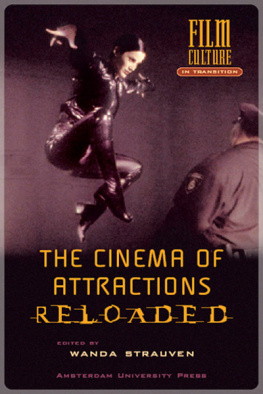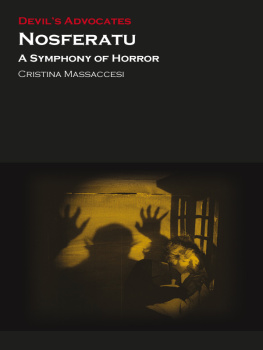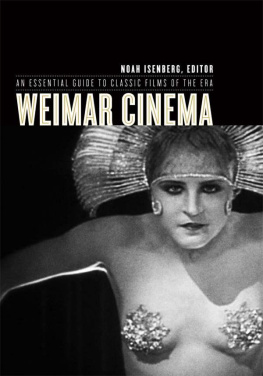Shell Shock Cinema

Mourning the dead. Ellen sits among crosses at the sea (from Nosferatu).
Shell Shock Cinema: Weimar Culture and the Wounds of War
Anton Kaes

Copyright 2009 by Princeton University Press
Published by Princeton University Press, 41 William Street, Princeton, New Jersey 08540
In the United Kingdom: Princeton University Press, 6 Oxford Street, Woodstock, Oxfordshire OX20 1TW
press.princeton.edu
All Rights Reserved
Third printing, and first paperback printing, 2011
Paperback ISBN 978-0-691-00850-9
The Library of Congress has cataloged the cloth edition of this book as follows Kaes, Anton.
Shell shock cinema : Weimar culture and the wounds of war / Anton Kaes.
p. cm.
Includes bibliographical references and index.
ISBN 978-0-691-03136-1 (hardcover : alk. paper) 1. Motion picturesGermanyHistory20th century. 2. World War, 1914-1918Motion pictures and the war. 3. World War, 1914-1918Influence. 4. Silent filmsGermanyHistory and criticism. 5. War and motion pictures. 6. Psychic trauma in motion pictures. 7. Culture in motion pictures. I. Title.
PN1993.5.G3K295 2009
833.909358dc22 2008053044
British Library Cataloging-in-Publication Data is available
This book has been composed in Minion and Myriad
Designed by Tracy Baldwin
Printed on acid-free paper.
Printed in the United States of America
10 9 8 7 6 5 4 3
Contents
Illustrations
All frame enlargements courtesy of Friedrich-Wilhelm-Murnau
Foundation Wiesbaden.
Acknowledgments
This book owes most to my students at Berkeley. For almost three decades they have shared my belief that Weimar cinema still speaks to us. Their enthusiasm has inspired my research and their probing questions have sharpened my sense of Weimars uncanny presence in our time. I also owe thanks to my students in a seminar at Tel Aviv University, whose observations substantially nuanced and expanded my understanding of post-traumatic cinema.
I am indebted to the many interlocutors, often anonymous, at conferences, symposia, workshops, and lectures in various parts of the United States and in Seoul, Beijing, Canberra, Jerusalem, Vienna, London, Cambridge, Amsterdam, and Berlin. Unknowingly they have contributed to the book in its present form. I am grateful to the generous hosts of the various events for inviting me to present my work in progress.
My greatest thanks go to my friend and colleague Eric Rentschler, loyal collaborator for more than thirty years, who has accompanied this book from the beginning. The shape and substance of this project became clearer to me in the course of our many discussions. I also thank Edward Dimendberg, trusted friend and co-editor of our Weimar and Now book series, who read the manuscript at a crucial stage and claimed it was finished. Both Rick and Ed are the hidden coauthors of this book, along with Paul Dobryden, my brilliant research assistant, who was instrumental in readying the manuscript for print. Many of my students over the years (most of them colleagues now and some of them Weimar film scholars in their own right) have been involved with the subject of this book in one way or another: Eric Ames, Maya Barzilai, Christian Buss, Steve Choe, Michael Cowan, Melissa Etzler, Sara Hall, Dayton Henderson, June Hwang, Noah Isenberg, Jennifer M. Kapczynski, Kristin Kopp, Barbara Kosta, David Levin, Rick McCormick, Robert Schechtman, Gabriel Trop, Justin Vaccaro, Chad Wellmon, Jennifer Zahrt, and especially David Gramling. There were others, including undergraduate students in my film noir classes, who have challenged my thinking. The book is a product of the many ideas generated in Berkeleys collaborative intellectual environment; nonetheless it goes without saying that all errors and weaknesses are mine alone.
I was privileged to discuss lesser-known Weimar films with colleagues at the bi-annual German Film Institute during the summers of 2004 and 2006 in Ann Arbor. Our spirited exchanges brought the cinema under discussion to life in surprising and compelling ways. I want to thank Johannes von Moltke of the University of Michigan for organizing this exciting forum and the participants of the GFI for their lively contributions.
I am grateful to my friends Nurith Gertz, Roger Hillman, Walter H. Sokel, and David Bathrick, who read the manuscript or parts of it and made excellent suggestions. Other colleagues discussed aspects of the book with me or shared materials: Stefan Andriopoulos, Moritz Bassler, Elisabeth Bronfen, Yun-Young Choi, Jason Crouthamel, Thomas Elsaesser, Michal Friedman, Gerd Gemnden, Michael Geyer, Sander Gilman, Deniz Gktrk, Tom Gunning, Miriam Hansen, Hans-Georg Hofer, Bernd Hppauf, Martin Jay, Christian Kiening, Gertrud Koch, Niklaus Largier, Paul Lerner, Helmut Lethen, Sandra Meiri, Raya Morag, Yael Munck, Lutz Musner, Judd Neeman, Kaja Silverman, Philipp Stiasny, Cornelia Vismann, Joseph Vogl, Wilhelm Vosskamp, Andrew Webber, Jay Winter, and Anat Zanger. Special thanks go to Elaine Tennant for help with the Nibelungenlied. I also want to thank my friends at the Deutsche Kinemathek Berlin, who have, as always, been inordinately helpful, especially Gero Gandert, Peter Latta, Hans Helmut Prinzler, Rainer Rother, Christine Seuring, and Werner Sudendorf.
The book could not have been completed without the generous support of several organizations and institutions. First of all, I thank the Alexander von Humboldt Foundation for awarding me the Humboldt Prize, as well as Klaus W. Scherpe and Joseph Vogl for hosting me at the Humboldt University of Berlin. I also extend my thanks to the Mortimer and Raymond Sackler Institute of Advanced Studies (especially Abraham Nitzan and Ronit Nevo) for inviting me to be a Fellow in Residence at the University of Tel Aviv. I am further grateful to the University of California for granting me the Presidents Research Fellowship and to Berkeleys Division of Arts and Humanities (especially Dean Janet Broughton and former Dean Ralph Hexter) for their longstanding support.
All illustrations come from original 35mm film copies, and I want to thank Gerhard Ullmann of the Munich Film Museum for making the frame enlargements with his inimitable skill and care. I thank the Friedrich-Wilhelm-Murnau Foundation for granting me permission to reproduce these images. My editors at Princeton University Press, Hanne Winarsky and Mary Murrell before her, deserve the highest praise for their boundless patience and unflagging support. I also thank Mark Bellis for shepherding the book through production with great efficiency and Eva Jaunzems for her passionate copyediting. Although none of the chapters have been published in their present form, the book draws on my previous research on Weimar cinema and culture. Parts of Chapter 2 appeared as The Cabinet of Dr. Caligari: Expressionism and Cinema in Masterpieces of Modernist Cinema, Ted Perry, ed. (Bloomington: Indiana University Press, 2006); portions of Chapter 4 appeared as SiegfriedA German Film Star Performing the Nation in Langs Nibelungen Film in The German Cinema Book, Tim Bergfelder, Erica Carter, and Deniz Gktrk, eds. (London: British Film Institute, 2002); and parts of Chapter 5 (pursuing a different argument) appeared as Metropolis: City, Cinema, Modernity in
Next page







